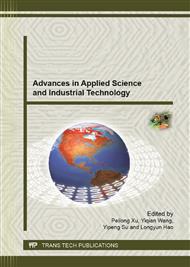[1]
H. Y. Yang: North environment (In Chinese) Vol. 1(2010), pp.79-80.
Google Scholar
[2]
W. J. Zhao, et al.: Intelligence (In Chinese) Vol. 21(2009), p.249.
Google Scholar
[3]
Q. Liu and Y. Wang: Guizhou Chemical Industry (In Chinese) Vol. 1(2010), pp.42-44.
Google Scholar
[4]
C. L. Wu: Qinghai Environment (In Chinese) Vol. 18(2008), pp.36-38.
Google Scholar
[5]
S. Rio,C. Faur-Brasquet,L. Le Coq,et al.: Water Science and Technology Vol. 49 (2004), pp.139-146.
DOI: 10.2166/wst.2004.0041
Google Scholar
[6]
S. Rio, C. Faur-Brasquet, L. Le Coq,et al.: Environmental Science and Technology Vol. 39 (2005), pp.4249-4257.
DOI: 10.1021/es0497532
Google Scholar
[7]
H. L. Chiang, C. G. Chao,C. Y. Chang,et al.: Water Research Vol. 35 (2001), pp.4331-4338.
Google Scholar
[8]
Jeyaseelans and L. G. Qin: Water Science and Technology Vol. 34(1996), pp.499-505.
Google Scholar
[9]
S. Rio, C. Faur-Brasquet, L. Le Coq, et al.: Adsorption Vol. 11 (2005), pp.793-798.
DOI: 10.1007/s10450-005-6025-1
Google Scholar
[10]
A. Méndez, G. Gascó, M. M. A. Freitas, et al.: Chemical Engineering Journal Vol. 108 (2005), pp.169-177.
Google Scholar
[11]
Z. H. Li and Q. M. Sun: Light Industry Science and Technology Vol. 4(2012), pp.101-103.
Google Scholar
[12]
B. Li, R. H. Shao, P. Fang, et al.: Henan Chemical Industry. Vol. 28(2011), pp.21-26.
Google Scholar
[13]
L. L. Li, J. W. Jiang, Y. Jin, et al.: Chinese Journal of Environmental Engineering. Vol. 1 (2007), pp.119-122.
Google Scholar
[14]
J. Ozaki,N. Endo, W. Ohizumi, et al.: Carbon Vol. 35 (1997), pp.1031-1033.
Google Scholar
[15]
F. Rozada, M. Otero, J. B. Parra, et al.: Chemical Engineering Journal Vol. 114 (2005), pp.161-169.
Google Scholar
[16]
M. Seredych and T. J. Bandosz: Journal of Colloid and Interface Science Vol. 302 (2006), pp.379-388.
Google Scholar
[17]
K. Kante, J. S. Q iu, Z. B. Zhao, et al.: Applied Surface Science Vol. 254(2008), pp.2385-2395.
Google Scholar
[18]
C. Jindarom, V. Meeyoo, B. Kitiyanan, et al.: Chemical Engineering Journal Vol. 133(2007), pp.239-246.
Google Scholar
[19]
J. H. Tay, X. G. Chen, S. Jeyaseelan, et al.: Chemosphere Vol. 44 (2001), pp.45-51.
Google Scholar
[20]
S. Rio, et al.: Chemosphere Vol. 58(2005), pp.423-437.
Google Scholar
[21]
Z.Q. Zhao, et al. ,Industrial water and wastewater(In Chinese) Vol. 40, 77 (2009), pp.77-79.
Google Scholar
[22]
M. J. Martin,A. Artola,M. D. Balaguer,et al.: Journal of Chemical Technology and Biotechnology Vol. 77(2002), pp.825-833.
Google Scholar
[23]
A. Bagreev, S. Bashkova, D. C. Locke, et al.: Environ. Sci. Technol Vol. 35(2001), pp.1537-1543.
Google Scholar


